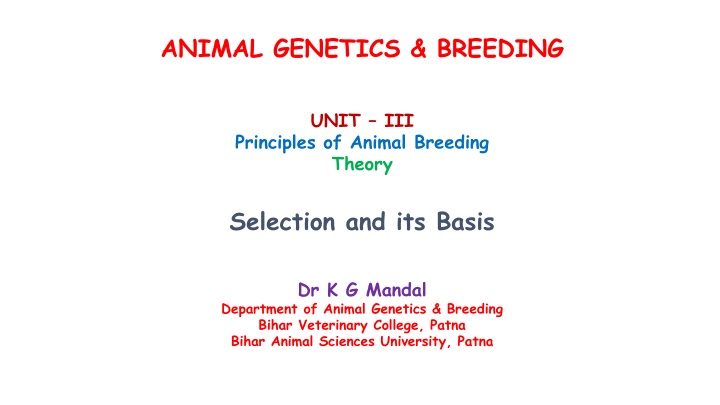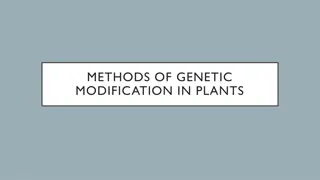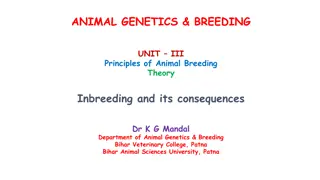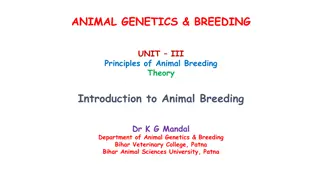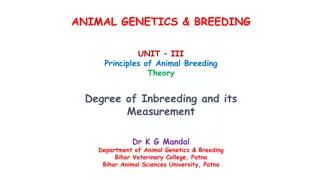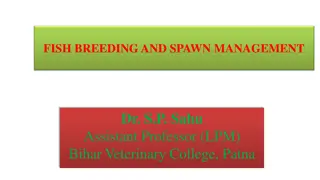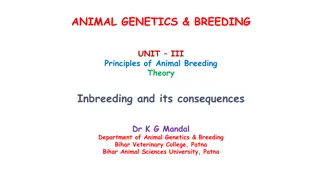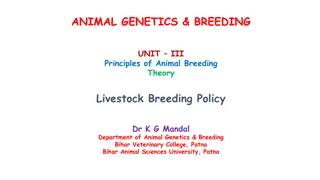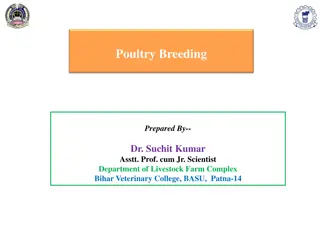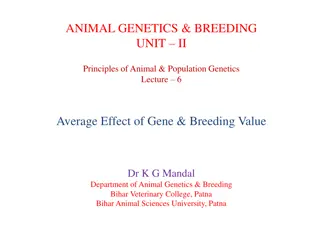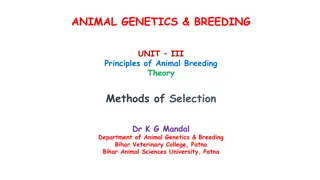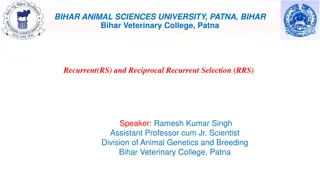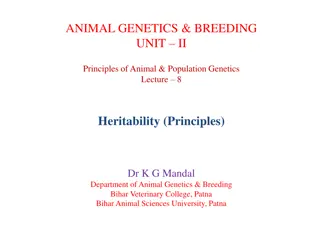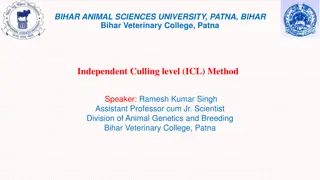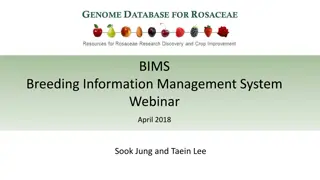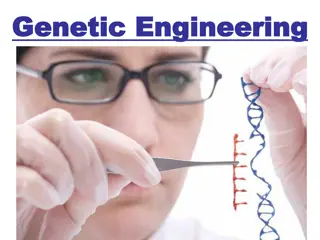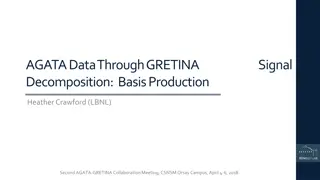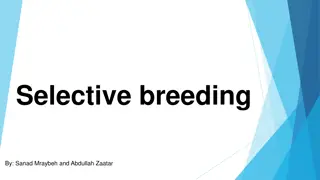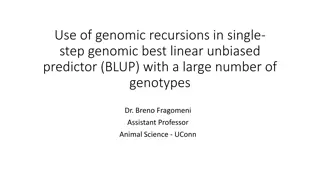Principles of Animal Breeding: Selection and its Basis
Selection in animal breeding involves choosing the best individuals to improve specific traits. Criteria for selection include individual merit, competitive exams, and interviews. Selection of farm animals focuses on non-random reproduction of genotypes. Types of selection include natural and artificial selection, each influencing genotype and gene frequencies. The objective is to enhance desirable traits and response to selection, while considering effective population size.
Download Presentation

Please find below an Image/Link to download the presentation.
The content on the website is provided AS IS for your information and personal use only. It may not be sold, licensed, or shared on other websites without obtaining consent from the author.If you encounter any issues during the download, it is possible that the publisher has removed the file from their server.
You are allowed to download the files provided on this website for personal or commercial use, subject to the condition that they are used lawfully. All files are the property of their respective owners.
The content on the website is provided AS IS for your information and personal use only. It may not be sold, licensed, or shared on other websites without obtaining consent from the author.
E N D
Presentation Transcript
ANIMAL GENETICS & BREEDING UNIT III Principles of Animal Breeding Theory Selection and its Basis Dr K G Mandal Department of Animal Genetics & Breeding Bihar Veterinary College, Patna Bihar Animal Sciences University, Patna
Introduction to selection Choosing of best individuals among the lot. Objective of selection? For further improvement in a particular field. Various Fields are: i. Wining of medal in Olympic games & sports ii. Wining of Nobel Prize (Nobel laureate) iii. Literacy & Cultural events singing, dancing (Mr. India & Miss India) iv. Higher education IIT, IIM, IISc, AIIMS, Science & Technology, Vety. & Agri. Science etc. v. Service Adm.(IAS), Engineer, Doctor, Professor, Scientist, Judge, Officer, Army, School teacher etc.
Criteria of selection Or Basis of selection? Individual merit only Method of selection: Competition Competitive exam Interview Competitive exam & Interview both Group discussion Physical fitness Medical test Accuracy of selection the factors which increase the efficiency of selection selection index or total score
Selection of farm animals Definition: 1. According to Prof. I M Lerner: selection is the non- random differential reproduction of different genotypes. i. Differences in fertility among individuals in parent generation ii. Differences in viability among the progeny iii. Choice of mated individuals differential reproductive rates within the population whereby some individuals tend to have more offspring than the others. i. All individuals are not allowed to be the parents. ii. Difference in fitness from individual to individual. 2. According to Prof. Jay L Lush: selection is the
Types of selection Natural Selection Selection operates through natural forces like fertility and viability. Nature selects individuals which are more adaptable and more fit in a particular environment. Artificial Selection Selection operates through intervention of man (animal breeder) Superior individuals will be allowed to be the parents for next generation. Natural selection favours artificial selection.
Effect of Selection : i. There will be change of genotype frequency and gene frequency. ii. It increases the frequency of desirable genes iii. It does not create new genes in the population iv. As a result of selection there will be change of population mean. Objective of selection: i. To increase the mean value of performance traits in subsequent generations. ii. To maximize the response to selection. iii. To decide the minimum effective population size (Ne).
Ne = Number of individuals that would give rise the same rate of inbreeding in every generation. 1 1 4?+ 1 4?? ?+? , and 1 1 8? + 1 4? or, Ne = 2?? = 8? ??= Where, S = no. of sires and D = no. of dams 1 The increase in inbreeding per generation is about F = 2??? Where t is the generation interval in terms of year. It is suggested that there should be sufficient Ne to reduce inbreeding, F, less than 1% per year.
Criteria or Basis of Selection Breeding value is the only criteria of selection. Value associated with the genes carried by an individual is the B.V. The sources of information based on which the breeding value of an individual is estimated are called as the basis of selection or aids to selection or criteria of selection. Breeding value of an individual is estimated either from the phenotypic value of the individual itself or from the phenotypic value of its relatives. Information from relatives is very important to estimate the breeding value of an individual. Because there are certain percentage of genes which are common between individual and its relatives due to common ancestry.
Use of information from relatives is very important to estimate the breeding value of the individual under the following conditions: i. When individual selection is not possible. a. Sex-limited traits milk production, egg production b. Traits can not be measured in living animals slaughter traits ii. When selection is required at the earlier age but the trait is expressed later in life. iii. When h2 of the trait under selection is low. The breeding value so obtained is known as estimated breeding value (EBV) or probable breeding value (PBV) or predicted breeding value.
Basis of Selection The sources of information based on which the breeding value of an individual is estimated are called as the basis of selection or Principles of selection or Criteria of selection. 1. Individual Selection 2. Pedigree selection 3. Family selection 4. Within family selection 5. Sib selection 6. Progeny testing
1. Individual Selection Selection is made on the basis of own performance or own phenotypic value. When breeding value of an individual is estimated based on its own phenotypic value, then it is known as individual selection. Individual selection is also known as mass selection when selected individuals are kept together en mass for mating. Example: Drosophila and Tribolium Conditions applied for individual selection: (i) when traits are expressed in the individual and (ii) when h2 of the trait is high (iii) when mating records are maintained
Estimation of breeding value : breeding value (BV) of an individual is estimated from the phenotypic value of the individual as a deviation from the population mean (selection differential) times the h2 of the trait and known as Probable Breeding Value (PBV). PBV = P + h2(Pi P) Where, P = Population mean, h2 = heritability Pi = phenotypic value of the individual
Accuracy of individual selection: It depends on magnitude of rAP Correlation between breeding value and phenotypic value (rAP ) is equal to the square root of h2 (rAP = h) The accuracy of predicting the breeding value of an animal will be increased with the increase in magnitude of h2. Efforts must be made to get accurate estimation of h2 by reducing the environmental variations, and by estimating h2 based on repeated records of individual.
Limitation of individual selection: 1. Cannot be applied for sex-limited traits. 2. Cannot be selected If the traits are expressed later in life or after death of individual (slaughter traits) 3. Traits with low h2 is the limiting factor. When h2 is low, the phenotypic value is the poor indicator of breeding value. Since, h2 = r2AP and accuracy of selection h = rAP.
Advantages of individual selection: 1. Information of the individuals are easily available. 2. It can be applied before progeny testing 3. Used when pedigree information are not available 4. Generation interval is shorter in comparison to progeny testing 5. It gives direct estimation of BV. Does not depends on relatives. 6. It allows greater estimation of selection differential than the progeny testing.
Aids to individual selection: Individual selection will be more difficult when: i. Heritability of the trait is low to medium ii. Information of relatives are not available When h2 of a trait is low, the repeated records of the same animal can be used for estimation of breeding value. Use of part records and genetic correlation among the traits will be helpful when earlier selection is practiced for the traits expressed later in life. 1. Additional records 2. Most probable producing ability (MPPA) 3. Use of part records
1. Additional Records: Useful for traits repeated in life time Milk production (LMY), Wool production, Egg production etc. Advantageous to predict BV based on mean of several records. h2 for mean of n records, with repeatability, r, is taken as: ? 2 1+ ? 1 ? Accuracy of selection using n records will be equal to h2n ? 2 1+ ? 1 ? Accuracy of selection for single record, rAP = 2 Relative efficiency (ratio) = rAP rAP = h2n = rAP = ? 2 ? 1+ ? 1 ? 2 = 1+ ? 1 ?
2. Most Probable Producing Ability (MPPA): Useful for the traits repeated several times in life time. Efficiency of producing ability or MPPA depends on number of measurements and repeatability of the trait. MPPA = M + 1+ (? 1)?(O - M) where, M = herd average r = repeatability n = number of measurements on the same animal O = Individual s own performance ??
3. Use of part records: Genetic gain by use of part records, G = bAP(XPi XP) where, bAP = regression of breeding value on part records Xpi = part record of individual animal XP = Mean part records of population (XPi XP) = Selection differential
2. Pedigree Selection Selection of an individual based on performance of its ancestors is known as pedigree selection. Pedigree is the systematic list or records of ancestors of an individual. Ancestors are parents, grand parents, great grand parents, etc. Pedigree having information on the economic traits of ancestors is useful for selection of an individual. Breeding value of an individual is estimated on the basis of performance of ancestors.
Basis of pedigree selection: An individual is related by 50% with its parents, 25% with grand parents, 12.5% with great grand parents and so on. The relationship is reduced to half in each generation due to halving nature of inheritance. It is thus more important to consider recent ancestors (parents) than the remote ancestors for pedigree selection. Inclusion of more remote ancestors results only in marginal gain. Pedigree selection adds very little to the accuracy of estimating BV of an individual if information on individual are available.
Significance of pedigree selection decreases when information are available either on individual or its family members (sibs & progeny). Guide to the pedigree selection: Degree of genetic relationship more closely related ancestors should be given more emphasis. Heritability of the character pedigree selection is more accurate for characters of high h2. Information should be available on ancestors.
Advantages of pedigree selection: Allows selection at younger age. It is helpful in multistage selection. It is useful for sex-limited traits and traits expressed later in life or after death of animal (eg. slaughter traits). It is helpful when two individuals have similar performance but one belongs to a better pedigree. It is less costly, as only compilation of pedigree is required.
Demerits of pedigree selection: Characters with low h2 can not be improved to the level of expectation. Some pedigree gets undue emphasis and favoured. Better environment is provided to the favoured pedigree. Pedigree selection provides no basis of selection among individuals when descendants are from the same ancestors.
Estimation of Breeding Value (BV): The BV of an individual from pedigree records is estimated by the selection differential of its relatives (P) taken as a deviation from their contemporary average (Pc) times the regression of the genotype of the individual on the mean phenotypic value of the relatives (bAP) and added to the mean of contemporary group as: P.B.V. = Pc + bAP(P Pc) The bAP is taken as rh2 where r is the coefficient of relationship between the individual and its relatives. In estimating the PBV of an individual the record(s) of one parent or both parents or parents and grand parents can be used. The information on ancestors combined with individual s own record increases the accuracy of selection.
Accuracy of pedigree selection: The selection based on the performance of one parent is half as effective (accurate) as that based on individual s own performance. The information on records of both the parents plus all the four grand parents gives lesser accuracy of selection which does not exceed 0.71 than based on individual s own record. The information on records of ancestors (both the parents plus all the four grand parents) combined with individual s own performance gives little higher accuracy of selection than based on individual s own record. The accuracy of selection based on single parent never exceed to 0.50.
3. Family selection Information from collateral relatives may be used for estimation the B.V. of an individual. Among the collateral relatives, full-sibs and half-sibs are more closely related to the individual. Full-sibs and half-sibs constitute full-sib family and half-sib family respectively. Selection of an individual on the basis of family mean is called family selection or sib selection depending upon inclusion or exclusion of individual s own performance in the family mean. Selection of an individual on the basis of family mean is called family selection when individual s own performance is included in the estimation of family mean.
In family selection the criteria of selection is based on the performance of sibs plus individual s own record. Types Full-sib family selection & half-sib family selection. Family will be taken as a unit and depending upon family mean the whole family will be selected or rejected. If the family is selected, then the inferior individual of the family should also be selected. If the family is rejected, the superior individual of the family will also be rejected. Family selection is practiced for the following traits for which measurements of individual are not available: i. Traits with low heritability and high reproductive rate litter size
Sib selection: Selection of an individual on the basis of family mean is called sib selection when individual s own performance is not included in the estimation of family mean. An individual is selected on the basis of average performance of sibs. Average performance of sibs is the criteria of selection. Depending upon types of sibs, it is two types Full-sib family selection and half-sib family selection.
Sib selection is practiced for improvement of the following traits for which measurements of individual are not available: Traits with low heritability and high reproductive rate litter size Sex-limited traits milk production, egg production Traits can not be measured on the individual slaughter traits
Advantages of family selection: It is suitable for traits with low heritability and high reproductive rate. Eg. Litter size in pig, egg production. It reduces generation interval. It is an aid to individual selection because it is better to select an individual from a superior family. Limitation: It leads to inbreeding Full-sib family selection can only be applied in species with high reproductive rate to get large family size. Family selection is costly since large number of families are required to be maintained.
4. Progeny Testing Selection of an individual based on it s progeny performance is known as progeny selection or progeny testing. It is the most important basis of selection. Mean phenotypic value of the progeny is taken as the deviation from mean phenotypic value of contemporaries. Each progeny inherits one-half of the genes from each parent due to halving nature of inheritance. This is taken as transmitting ability of the parent. Hence B.V. of the parent is twice the mean deviation of the progeny from the population mean. B.V. = 2(M P) Where, M = progeny mean, P = population mean
Superiority of P. T. over other selection criteria: Individual selection is not possible for traits of low h2, sex limited traits and the traits expressed after death of individual. Pedigree selection is based on performance of dams. Due to halving nature of inheritance it is not possible to know that which half (better or inferior) of dam s genes is received by the progeny. Accuracy of sib selection is also low due to sampling nature of inheritance. In progeny testing, the performance of many progenies gives the best and most reliable information about the genetic merit of the individual (parent).
Precautions in Progeny Testing: Adult females should be allotted randomly to all the sires under test to avoid the effect of dam on progeny. Different sire groups should be raised and compared under similar environmental conditions i.e., same management practices. Progeny should be born in the same season and year as well as same age/lactation. All the healthy animals should be included, and excluded those which would not complete lactation length. Data recorded should be adjusted/corrected for environmental effects such as year, season, lactation length, lactation number (parity), age etc. More number of progeny should be recorded per sire to cancel out randomly distributed sources of error.
Constraints in Progeny Testing: Small population size It can be solved by i. Associated herd progeny testing ii. Field progeny testing Unplanned mating this leads to wastage of data and non- orthogonality of data. To have equal number of daughter per sire mating should be well planned.
Methodology of Progeny Testing: To overcome population size, the PT programme should be carried out in associated herds. About 4-5 males should be kept under test for each required progeny tested bull. About 50 progenies should be settled from each bull to get about 10 daughters per bull. About 8-10 bulls should be tested per batch to get atleast 2 top ranking bulls. It is better to complete the test within the period of 2 years. Atleast 10,000 semen doses cryopreserved from proven bull for AI programme. should be prepared and
Breeding Value: The breeding value of bull = Pc + bAP(Pi Pc) Where, Pc = Contemporary progeny average i.e., average of all progeny performance under all the bulls put under test. Pi = Progeny average of a particular bull. bAP = regression coefficient i.e, regression of B.V. of parent on the phenotypic performance of the progeny. bAP = rnh2 / [1+(n-1)t] = 0.5nh2 / [1 + (n-1)t = nh2 / [1 + (n-1)0.25h2] = 2nh2 / [4 + (n 1)h2] (Pi Pc) = selection differential PBV = Pc + b(Pi Pc) = Pc + 2? 2 4+ ? 1 2 (Pi Pc)
Advantages of Progeny testing: Progeny testing is suitable for i. sex limited traits ii. traits with low h2 iii. slaughter traits It increases intensity of selection Accuracy increases with the increase in progeny number. Useful for identification of recessive genes, if present, in the bull put under test.
Limitations of Progeny Testing: Time and cost is the main limiting factor. Increases generation interval genetic gain per unit of time is low.
